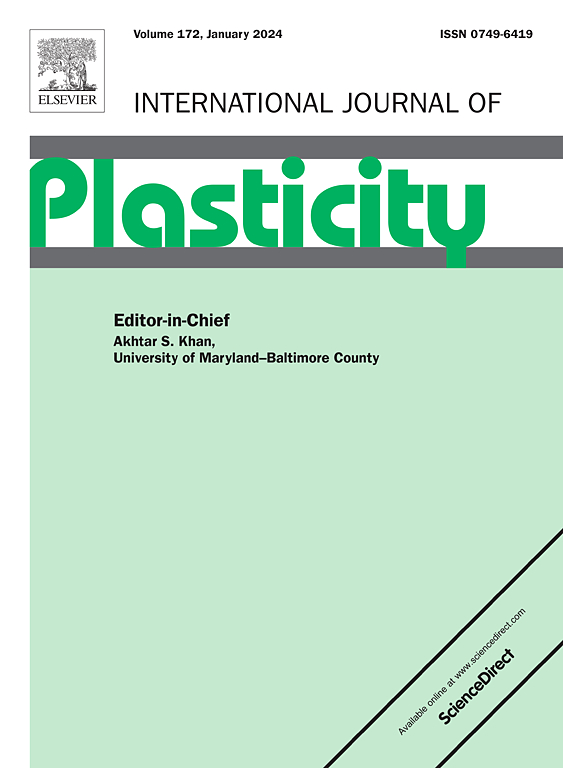导致损伤条件下低晶粒多晶非均质应力分布的归因
IF 9.4
1区 材料科学
Q1 ENGINEERING, MECHANICAL
引用次数: 0
摘要
在高纯度多晶金属材料中,由于颗粒相互作用产生的应力状态升高和相对原子无序导致的晶界减弱,孔洞倾向于晶界作为成核点。为了量化这种高应力状态的关键因素,使用包含非施密德效应的单晶塑性模型模拟了体心立方钽小多晶圆柱体的简单压缩。四种越来越复杂的合成微观结构被创造出来,以可追踪地结合晶界相互作用,并且通过改变微观结构的初始晶体学取向进行了统计上显著数量的组合。这些模拟大多在晶界处产生最大的von Mises应力,而在多晶界处产生的应力较少。为了建立晶界处最大von Mises应力的统计模型,选择了可能导致应力状态升高的物理特征。然后,使用基于信息论的学习算法来识别哪些特征对数据集贡献了最多的信息。确定的特征包括晶粒的倾向,以适应弹性和塑性变形及其方向成分。结果表明,晶粒力学响应方向的偏差与晶界附近应力的大小密切相关。对于所有的合成微观结构,统计模型产生的残差分布接近高斯分布,方差最多为先验分布的10%。统计模型的成功执行意味着正确识别导致多晶材料严重应力局部化的物理特征。本文建立的统计模型可用于建立物理驱动的空洞成核模型,该模型对微观结构产生高应力状态的倾向很敏感。这些统计模型还可以用于材料微观结构的设计,其中晶体取向的选择可以抵抗空穴成核。本文章由计算机程序翻译,如有差异,请以英文原文为准。
Attribution of heterogeneous stress distributions in low-grain polycrystals under conditions leading to damage
In high-purity polycrystalline metallic materials, voids tend to favor grain boundaries as nucleation sites due to the elevated stress states produced by granular interactions and the weakened grain boundary from the relative atomic disorder. To quantify the key factors of this elevated stress state, simple compression of a small multi-grain cylinder of body-centered cubic tantalum was simulated using a single crystal plasticity model that incorporates non-Schmid effects. Four increasingly complex synthetic microstructures were created to tractably incorporate grain boundary interactions, and a statistically significant number of combinations were performed by varying the initial crystallographic orientations of the microstructure. Most of these simulations produce the maximum von Mises stress on a grain boundary and less frequently at the multi-grain junctions. To build a statistical model for the maximum von Mises stress at the grain boundary, physically based features that could contribute to the elevated stress state were selected. Then, a learning algorithm based on information theory was used to identify which of these features contributed the most information to the data set. The identified features include a grain’s propensity to accommodate both elastic and plastic deformations and their directional components. The misalignment of the direction of each grain’s mechanical response was found to be strongly correlated to the magnitude of the stress near the grain boundary. For all of the synthetic microstructures, the statistical models produce a residual distribution that is nearly Gaussian with a variance of, at most, 10% of the prior distribution. The successful performance of the statistical model implies the correct identification of the physical features that cause severe stress localization in polycrystalline materials. The statistical models constructed here can be used to formulate a physically motivated void nucleation model which is sensitive to a microstructure’s propensity to produce elevated stress states. These statistical models also enable the design of material microstructures, in which the crystallographic orientation is chosen to resist void nucleation.
求助全文
通过发布文献求助,成功后即可免费获取论文全文。
去求助
来源期刊

International Journal of Plasticity
工程技术-材料科学:综合
CiteScore
15.30
自引率
26.50%
发文量
256
审稿时长
46 days
期刊介绍:
International Journal of Plasticity aims to present original research encompassing all facets of plastic deformation, damage, and fracture behavior in both isotropic and anisotropic solids. This includes exploring the thermodynamics of plasticity and fracture, continuum theory, and macroscopic as well as microscopic phenomena.
Topics of interest span the plastic behavior of single crystals and polycrystalline metals, ceramics, rocks, soils, composites, nanocrystalline and microelectronics materials, shape memory alloys, ferroelectric ceramics, thin films, and polymers. Additionally, the journal covers plasticity aspects of failure and fracture mechanics. Contributions involving significant experimental, numerical, or theoretical advancements that enhance the understanding of the plastic behavior of solids are particularly valued. Papers addressing the modeling of finite nonlinear elastic deformation, bearing similarities to the modeling of plastic deformation, are also welcomed.
 求助内容:
求助内容: 应助结果提醒方式:
应助结果提醒方式:


